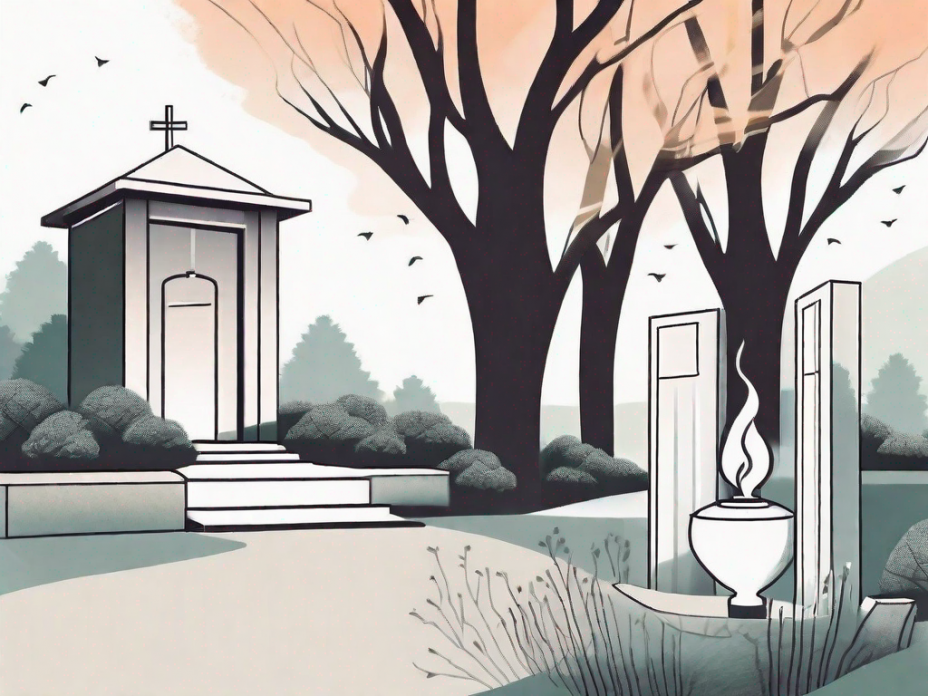Cremation has become increasingly popular as an alternative to traditional burial in recent years. It offers a range of choices that can be tailored to meet individual preferences and cultural traditions. In this comprehensive guide, we will explore all aspects of cremation services, including the basics of cremation, the different types of services available, the planning process, the associated costs, legal and ethical considerations, and a comparison between cremation and burial. Additionally, we will discuss the importance of understanding the grieving process and provide resources for support in dealing with loss.
Understanding Cremation Services
The Basics of Cremation
Cremation is a method of final disposition of a deceased individual, where the body is reduced to ashes through the process of intense heat and flame. This is typically carried out in a dedicated facility, known as a crematorium. The remains, known as cremated remains or cremains, are then given to the family, who may choose to keep them in an urn, scatter them in a meaningful location, or perform other memorialization options.
The Cremation Process Explained
The cremation process involves several steps to ensure that it is conducted respectfully and in accordance with legal requirements. Firstly, the body is prepared by removing any metal objects, such as jewelry or medical implants, that might interfere with the cremation process. This is done to ensure the safety of the cremation equipment and to prevent any potential damage to the environment during the process.
Once the necessary preparations have been made, the body is placed in a container, typically a casket or an alternative container approved for cremation. It is important to note that embalming is not required for cremation. Unlike traditional burial, where embalming is often performed to preserve the body for viewing, cremation allows for a more natural process, as the body will be reduced to ashes.
Once the body is securely placed in the container, it is then transferred to the cremation chamber. The chamber is specially designed to withstand the high temperatures required for the cremation process. Inside the chamber, the container holding the body is exposed to extreme heat, usually between 1400 and 1800 degrees Fahrenheit. This intense heat and flame gradually reduce the organic matter to bone fragments.
After the body has been reduced to bone fragments, these fragments are carefully collected and further processed to create a fine powder. This powder is what is commonly referred to as the cremated remains. The remains are then placed in a temporary container or an urn, depending on the family's preference. The family can choose to keep the urn at home, place it in a columbarium, or scatter the remains in a location that holds special meaning to the deceased.
It is worth noting that cremation offers families a wide range of memorialization options. Some families choose to hold a traditional funeral service before the cremation takes place, while others opt for a memorial service after the cremation. Additionally, there are various ways to personalize the cremation process, such as incorporating religious or cultural rituals, selecting a unique urn, or arranging for a special scattering ceremony.
Overall, cremation provides a flexible and meaningful alternative to traditional burial. It allows families to honor their loved ones in a way that aligns with their beliefs and preferences. Whether it's keeping the cremated remains close by or scattering them in a cherished location, cremation offers a personalized and lasting tribute to those who have passed away.
Types of Cremation Services
When it comes to honoring the deceased and saying goodbye, cremation services offer a range of options to suit different preferences and needs. Let's take a closer look at the various types of cremation services available:
Direct Cremation
Direct cremation is the most basic and economical option for cremation services. In this type, the body is cremated shortly after death, without any formal viewing or ceremony. The simplicity and affordability of direct cremation make it a popular choice for those who prefer a more straightforward process.
While there may not be a formal ceremony, families can still choose to hold a private gathering or memorial service to honor their loved one's memory. This can be a time for sharing stories, memories, and finding solace in the presence of close friends and family.
Cremation with Memorial Service
A cremation with a memorial service allows for the inclusion of a formal ceremony to honor and remember the deceased. The body is still cremated, but the memorial service can take place before or after the cremation. This option provides the opportunity for family and friends to gather and pay their respects in a meaningful way, while still benefiting from the flexibility that cremation services offer.
The memorial service can be personalized to reflect the life and personality of the departed. It may include music, readings, eulogies, and other elements that celebrate their unique journey. This type of service allows for a more structured and communal experience of remembrance.
Traditional Funeral followed by Cremation
Some individuals or families may opt for a traditional funeral service, followed by cremation. In this scenario, the body is embalmed, allowing for a viewing or visitation prior to the funeral. Following the funeral service and any other associated rituals, the body is then cremated. This option combines the elements of a traditional funeral with the benefits of cremation, offering a personalized and meaningful farewell.
By incorporating a traditional funeral service, loved ones have the opportunity to gather, share their grief, and find comfort in the presence of others. The viewing or visitation allows for a final chance to say goodbye and pay respects to the deceased. After the funeral service, the body is respectfully cremated, providing a more environmentally friendly option compared to traditional burial.
Additionally, families may choose to hold a separate memorial service or scattering ceremony after the cremation, allowing for further closure and remembrance.
Regardless of the type of cremation service chosen, it is important to remember that each option can be tailored to meet the unique needs and wishes of the deceased and their loved ones. Cremation services offer flexibility, affordability, and the opportunity for personalized tributes, ensuring a meaningful farewell for those left behind.
Planning a Cremation Service
Steps to Plan a Cremation Service
Planning a cremation service involves several important steps to ensure that the wishes of the deceased and their loved ones are met. Firstly, it is important to identify the type of cremation service desired, whether it is a direct cremation, a cremation with a memorial service, or a traditional funeral followed by cremation. Consulting with a funeral director or cremation service provider is crucial to understanding the options available and making informed decisions.
Next, considerations such as the choice of urn, location for scattering the remains, or memorialization options should be discussed. It is essential to communicate these preferences to family members, as well as making them known in advance through written documentation such as a will or pre-arrangement plan.
Important Considerations in Planning
When planning a cremation service, there are important considerations to keep in mind. First and foremost, it is crucial to check the legal requirements regarding cremation in your jurisdiction. Some areas may have specific regulations that need to be followed, such as permits or documentation.
Family members should also be aware of any religious or cultural customs that may need to be incorporated into the service. Additionally, determining the appropriate time frame for the service and, if applicable, the transportation of the remains should be considered while planning.
Another important consideration is the selection of a suitable venue for the memorial service. This could be a funeral home, a place of worship, or even a meaningful location that held significance to the deceased. The choice of venue can greatly impact the atmosphere and overall experience for the attendees, so it is important to choose wisely.
Furthermore, it is crucial to consider the emotional and practical needs of the grieving family and friends. Planning a cremation service can be emotionally challenging, and it is important to provide support and resources to help them through this difficult time. This may include offering grief counseling services, providing information on support groups, or even organizing a post-service gathering to allow loved ones to come together and share their memories.
Additionally, when planning a cremation service, it is important to consider the financial aspects. Cremation costs can vary depending on the service provider and the specific arrangements made. It is advisable to obtain quotes from different providers and compare the services and prices offered. This will help ensure that the chosen service is within the budget and that there are no unexpected financial burdens for the family.
Lastly, it is important to keep in mind the environmental impact of cremation. While cremation is generally considered to be a more environmentally friendly option compared to traditional burial, there are still factors to consider. For example, some cremation providers offer eco-friendly urns made from biodegradable materials, which can help minimize the environmental footprint. It is worth exploring these options and discussing them with the service provider.
Costs Associated with Cremation Services
When it comes to cremation services, understanding the costs involved is crucial. The price can vary depending on several factors, including the type of service chosen and any additional customization or memorialization options. Let's take a closer look at the breakdown of cremation costs.
Breakdown of Cremation Costs
One of the most affordable options for cremation services is direct cremation. This involves a simple and expedited process, without the need for embalming or a traditional funeral service. Direct cremation allows families to focus on the essentials while keeping costs down.
On the other hand, a traditional funeral followed by cremation usually incurs higher costs. This is due to the inclusion of embalming, a casket, and other associated services. While this option provides a more traditional and elaborate farewell, it's important to consider the financial implications.
When planning a cremation service, it's crucial to obtain comprehensive quotes from cremation service providers. This ensures that all fees and potential additional costs are clearly outlined. By doing so, families can make informed decisions and avoid any unexpected financial burdens during an already difficult time.
Ways to Manage Cremation Expenses
Managing cremation expenses effectively is a priority for many families. Here are some strategies to consider:
1. Compare Prices and Services: It's always a good idea to compare prices and services from different cremation service providers. This allows you to find the best possible value without compromising on quality. By exploring different options, you may discover cost-saving opportunities.
2. Prepaid Cremation Plans: Another option to consider is prepaid cremation plans. These plans allow individuals to pay for their cremation services in advance, potentially locking in current prices. By doing so, you can relieve your loved ones of this responsibility in the future and ensure that your wishes are carried out as desired.
3. Explore Alternatives: Traditional funeral homes may not always be the most cost-effective choice. Direct cremation societies and basic cremation packages without any additional frills can offer more affordable alternatives. Balancing financial considerations with personal preferences is essential in creating an affordable and meaningful cremation service.
Remember, the cost of cremation services should not be the sole determining factor. It's important to find a balance between affordability and honoring the memory of your loved one. By exploring different options and discussing your needs with cremation service providers, you can create a meaningful farewell without breaking the bank.
Legal and Ethical Aspects of Cremation
Legal Requirements for Cremation
Each jurisdiction has specific legal requirements regarding cremation, which must be adhered to. These requirements typically include obtaining a cremation permit, filing the death certificate, and fulfilling any necessary documentation. It is important to consult with the appropriate authorities or a reputable funeral director to ensure compliance with these legal obligations.
In addition to the basic legal requirements, there are often other regulations that must be followed when it comes to cremation. For example, some jurisdictions may have restrictions on where cremations can take place, such as only allowing them to be performed in designated crematoriums. Other regulations may include guidelines for the handling and transportation of the deceased prior to cremation.
Furthermore, the legal aspects of cremation extend beyond the immediate process. There may be regulations regarding the disposal of the cremated remains, such as restrictions on scattering ashes in certain locations or requirements for their proper storage. It is crucial to be aware of and comply with these regulations to ensure that the cremation process is carried out in a legal and responsible manner.
Ethical Considerations in Cremation
Ethical considerations surrounding cremation often revolve around the respectful treatment of the deceased. Cremation should be carried out with dignity and care, ensuring that religious or cultural customs specific to the individual or their family are honored. Proper handling of the remains, clear communication with the family, and adherence to ethical standards are essential aspects of providing a compassionate cremation service.
One important ethical consideration in cremation is the consent of the deceased or their next of kin. It is crucial to obtain explicit permission before proceeding with cremation, as this ensures that the wishes of the deceased or their family are respected. In cases where the deceased did not leave any specific instructions, it is important to consult with the family and consider their preferences and beliefs.
Another ethical aspect of cremation is the environmental impact. While cremation is generally considered to be a more environmentally friendly option compared to traditional burial, there are still factors to consider. For example, the energy consumption and emissions associated with the cremation process should be minimized as much as possible. Additionally, the proper disposal of any materials used during the cremation, such as the container holding the remains, should be done in an environmentally responsible manner.
Furthermore, ethical considerations may also include the transparency and honesty of the cremation service provider. Families should be provided with clear and accurate information about the cremation process, including any associated costs, so that they can make informed decisions. It is important for cremation service providers to operate with integrity and to prioritize the well-being and satisfaction of the families they serve.
Cremation vs Burial: A Comparison
Key Differences between Cremation and Burial
Cremation and burial are two distinct methods of final disposition, each with its own advantages and considerations. The main difference lies in the physical transformation of the body. While cremation involves the reduction of the body to ashes, burial maintains the body's physical form.
Other key differences include the cost, environmental impact, and flexibility of memorialization options. Cremation services are often more cost-effective than traditional burials, and they offer flexibility in terms of memorialization, as the ashes can be kept in an urn, scattered, or used to create memorial jewelry or other keepsakes.
Factors to Consider in Choosing between Cremation and Burial
When deciding between cremation and burial, several factors should be taken into account. Personal beliefs, religious or cultural customs, environmental concerns, family preferences, and budget all play a significant role. Open discussions among family members and loved ones can help ensure that the chosen method of final disposition aligns with the wishes and values of the deceased. It is also helpful to obtain detailed information on the available options from funeral homes or cremation service providers.
Dealing with Grief and Loss
Understanding the Grieving Process
Grief is a natural response to the loss of a loved one, and understanding the grieving process can help individuals navigate this difficult journey. The grieving process is unique to each person, but it often involves stages such as denial, anger, bargaining, depression, and acceptance. It is important to recognize that grief may not follow a linear path and can be experienced differently by different individuals.
Seeking support from family, friends, or grief counseling professionals is highly recommended during this challenging time. Connecting with others who have experienced a similar loss can provide comfort and reassurance that one is not alone in their grief.
Support Resources for Those Dealing with Loss
Various support resources are available to those dealing with loss. Local bereavement support groups, online forums, and counseling services can offer guidance and comfort during the grieving process. Many organizations also provide grief support materials, such as books, articles, and websites, which can be valuable tools for coping with loss. Seeking solace in shared experiences and professional support can help individuals navigate their grief and gradually find healing and acceptance.


-banner.png)





